|
|
|

Temporary ( Private ) Page on the Ongoing Big C Treatment

This is a picture of the cancerous lesion before any treatment action was taken. Notice the obvious inflammation around the edges, and the slight swelling of the lesion itself. The size of the lesion itself is no larger than an eraser on a pencil. The irregular shape and slight protrusion indicated to me about eight months ago that this was a cancerous growth. Extreme Irritation and sensitivity, which began last week, confirmed this belief.
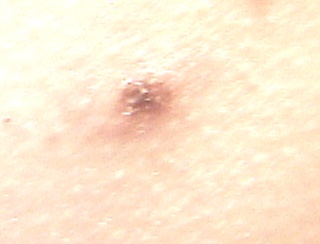
This is simply a "burned" picture of the lesion, taken at the same time as the above.

From farther back, it is easier to see the inflammation. Notice, that in cases of cancer, sometimes there is a secondary growth nearby ( just to the upper right of the original lesion ). I wish these digital cameras portrayed skin better! That's ugly!

This image was taken just after one clay poultice treatment. The only thing here to notice is the reduction of inflammation and swelling.

This was taken after the second one hour bentonite treatment. Notice the white ring ( much more evident viewing the actual area than on camera ) around the lesion. This tells me that the cancer had been spreading into surrounding tissues ( evident when the cancer "activated" last week, with irritation and sensitivity ). Notice that the lesion is nearly flush with the skin now, with no pronounced swelling. Through the years, I've noticed that when there is a WHITE skin reaction with any clay application, that an immune system deficiency is involved, especially evident in conditions such as Hodgkin's Disease. The nature of the reaction is endothermic. In such cases, the clay takes longer to achieve desired results than when there is no change in skin tone ( accept that which is caused by the pressure of the applied clay, of course ), or a reddening of the skin ( exothermic ).

After 2nd treatment ( image burned )

After the third natural clay treatment, I was very pleased with the improvement. The irritation was gone, and the tissues had begun to soften up significantly. Continued treatment may have yielded good results.

When the exchange of energy between the clay and the body is significant, perfectly concentric venting holes form in the clay. This is always a strong indication of a successful treatment. The marked hole was on lesion itself. Experience teaches one how to recognize the difference between simple formations in the clay due to clay separation, and actual "venting holes" which upon careful removal of the clay are always perfectly concentric. I've seen dime sized venting holes that span through 2 inches of clay ( dime sized at the point of contact, growing smaller the further away the clay is from the site ).

This is an image of the black salve "Cansema" ( http://altcancer.com/cansema.htm ), which had been applied to the lesion about four hours previously. Notice the red area around the lesion that nicely matches the white area that the clay treatments revealed in the photo earlier on this page. Instantly upon application, I experienced a relatively severe burning sensation, continued through the duration of the treatment. Using no pain medication, I would describe the pain as just below the comfortable conscious tolerance threshold.
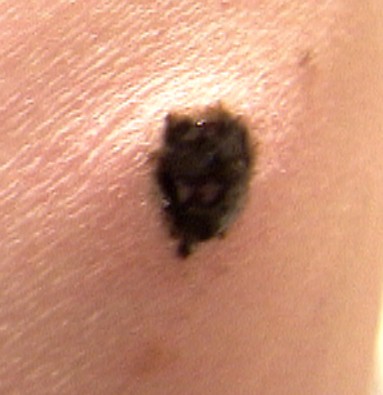
Cansema salve applied, twelve hours into treatment.


The image above and below, 24 hours after application
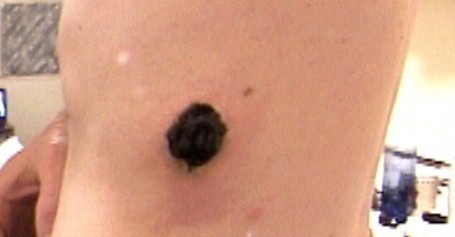
The following images were taken just after the Cansema was removed after 1 24 hour application, 3/2/02 7:53p





Having seen the underlying tissue, I wasn't comfortable with ending the treatment at this point. The affected area is current sized at just larger than a US quarter. The decision was made to to do a second application, for a duration of four hours for reevaluation.
Day Two ( after removal )
The pain involved was significant but not unmanageable.
After the cansema was removed, the wound was cleaned using a sterile sponge dressing soaked with an isolated silver solution made with a VERY small amount of hydrogen peroxide ( less than .05% estimated at time of application, the solution was made just moments before ).
The rapid relief was welcome although short-lived.
Next, isolated colloidal silver was delivered to the wound for five minutes using a "pressure method". A tall and thin shot glass filled with the solution, having a diameter slightly larger than the wound site, and applied with pressure to the wound. This was an unpleasant experience, and not necessarily needed. Cleaning the wound would have sufficed.
However, the CS solution quickly became cloudy with excess debris, and pronounced stinging indicated direct action of the silver.

The glass is filled to the brim with CS and applied carefully to the wound, eliminating dehydration of tissues through evaporation, and increasing the CS delivery via increased pressure.
Next, a thick natural bentonite pack was applied to a sterile gauze dressing, then applied to the wound, and secured for the night. The added weight of the clay contributed to increased uncomfort. However, the end result was well worth it. Between four and seven hours after application, the pain was completely erradicated, replaced by a deep and soothing feeling. This pain relief was not permanent, as the pain returned as a result of the activities of a busy day.
In the early afternoon ( about 11:00a ) the dressing was removed.



Notice that the bentonite did not adhere to the wound, and mostly lifted off in one peice. This is usually the case when "living" tissue is involved and the clay is used properly. The remaining clay was gently rinsed off. The area was then saturated with isolated silver by applying a dressing and soaking the dressing.

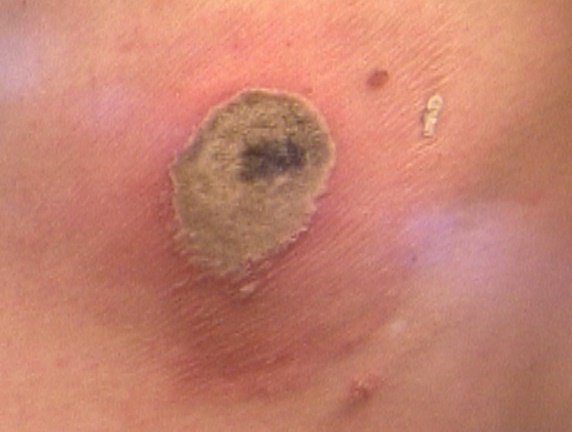
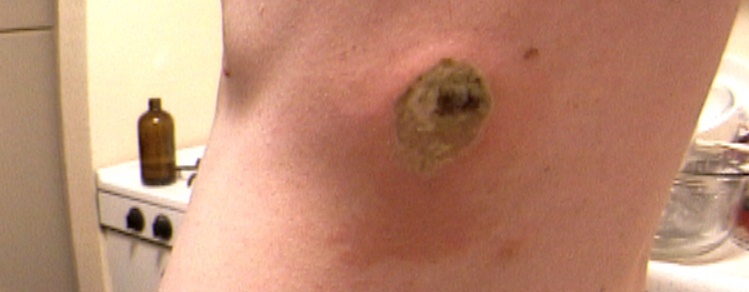



These are images of the natural bentonite poultice.
Day Four ( After Removal ) 3/5/02
The third day progressed as expected. A clay poutlice, about 1/4 inch thick was left on during daytime hours, secured to the area with a dressing. However, 3/4 through the day, I experienced weakness as a result of the clay pack. Reasonable caution needs to be employed when using clay over any organ location, as the clay DOES have a direct effect.
The thick clay poultice was discontinued for the night of the 3rd and the day of the fourth. This resulted in increased pain felt underneath the treatment area, as compared to the day previously. By evening hours ( after a long and busy day ), the overall pain had lessened significantly.


The waiting period has begun as the body moves to reject the now-dead tissues - the healing process has begun.
[ Page 2 ]